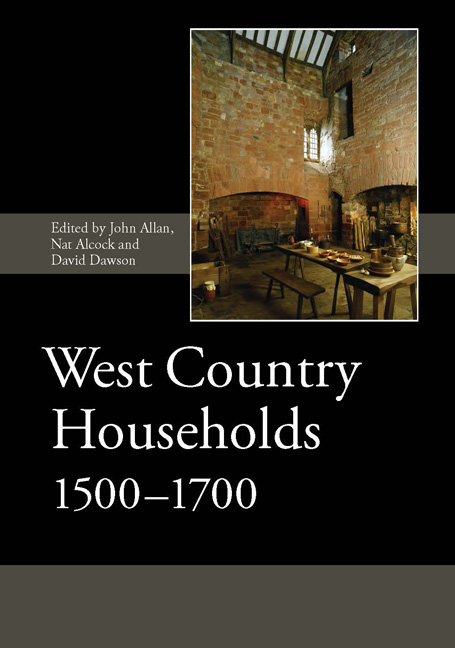Book contents
- Frontmatter
- Dedication
- Contents
- List of Illustrations
- List of Contributors
- List of Abbreviations
- Introduction
- I The Form and Development of West Country Houses
- 1 The Development of the Vernacular House in South-West England, 1500–1700
- 2 The Transformation of the Building Stock of Exeter, 1450–1700
- 3 The Appearances of Godolphin, Cornwall, c. 1300–c. 1630
- 4 Boiling Furnaces, Smoking Chambers and Malt Kilns in West Country Households
- II The Decoration of West Country Houses
- III The Material Culture of West Country Households
- Index of People and Places
- Index of Subjects
3 - The Appearances of Godolphin, Cornwall, c. 1300–c. 1630
from I - The Form and Development of West Country Houses
Published online by Cambridge University Press: 05 May 2015
- Frontmatter
- Dedication
- Contents
- List of Illustrations
- List of Contributors
- List of Abbreviations
- Introduction
- I The Form and Development of West Country Houses
- 1 The Development of the Vernacular House in South-West England, 1500–1700
- 2 The Transformation of the Building Stock of Exeter, 1450–1700
- 3 The Appearances of Godolphin, Cornwall, c. 1300–c. 1630
- 4 Boiling Furnaces, Smoking Chambers and Malt Kilns in West Country Households
- II The Decoration of West Country Houses
- III The Material Culture of West Country Households
- Index of People and Places
- Index of Subjects
Summary
Cornwall, on account of its remoteness, is probably a good region in which to look for meanings in the appearance of great places, their buildings, gardens and designed landscapes; the features of a seat such as Godolphin stand out all the more against a comparatively sparse field of competitors. The author, coming from a visual background, attempts to discover qualities which the documentary record can only hint at, even when supported by excellent archaeological observation. In the process, traces of the Godolphins' own perceptions of themselves in society emerge, as do routes by which the evidence of increasing sophistication reached the most westerly great house in the country.
INTRODUCTION
Godolphin lies in the lee of its hill, 4km from the sea, east of the isthmus between Mount's Bay and St Ives Bay, near the west end of the Cornish peninsula. Though its family moved away and died out in the 18th century, they had risen swiftly to prominence from the late 15th century through wealth generated from tin. This paper describes how this process is reflected in the evidence of the place itself.
In 1997 the Cornwall Archaeological unit (CAU), in the person of Peter Herring, produced a detailed archaeological and historical assessment of Godolphin, building on an earlier report by John Phibbs. Involvement in the information, research and interpretation stages moved the present author's long-term interest in the place (which had been concentrated mostly in the buildings) onto a new footing, opening up possibilities which had not existed previously. Interest was spurred in the mutually informative relationship between buildings, settings and landscape. The estate today at about 227ha is not particularly large, but it contains an outstanding density of above-ground archaeological sites and they cover a wide date-range. It is, of course, the overlapping of these which is so interesting for present purposes; that and the fact that, through much of the 20th century, Godolphin was treated with an unusual degree of respect.
- Type
- Chapter
- Information
- West Country Households, 1500–1700 , pp. 69 - 98Publisher: Boydell & BrewerPrint publication year: 2015



